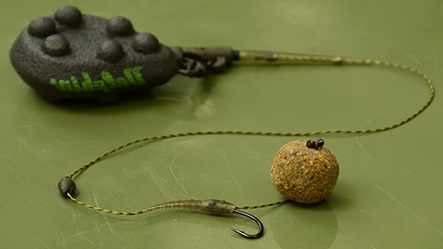Ciężarek w gruntowym zestawie.
Jak zamontować ciężarek w gruntowym zestawie na karpie? Przelotowo czy na stałe? Nicolas dzieli się swoimi spostrzeżeniami.

Nic tak nie przeszkadza wędkarzowi w łowieniu karpi, jak kurczowe trzymanie się pewnych przyzwyczajeń. Wielu kolegów ciągle używa bowiem tych samych zestawów, niezależnie od pory roku, czy warunków panujących nad wodą. Nie ma mowy o jakichkolwiek: zmianach – skoro raz udało się złowić kilka ładnych ryb, to zestaw gruntowy na karpie zawsze już musi być taki sam. Ja także często się na tym łapię. Przyjeżdżam nad wodę, szybko rozkładam wędki i niekiedy w ogóle nie zastanawiam się, dlaczego montuję taki, a nie inny zestaw. Ostatecznie, skoro do tej pory udawało się łowić karpie na taki zestaw, dlaczego dziś miałoby być inaczej? Później wracamy zmartwieni do domu o kiju i po raz kolejny sami siebie usprawiedliwiamy, że dzisiaj ryby w ogóle nie chciały brać.
Spostrzeganie brań.
Bezmyślne wykonywanie zestawu na karpie jest poważnym błędem. Musimy bowiem zdawać sobie sprawę, że każdy zestaw ma swoje plusy i minusy. Nie ma uniwersalnych zestawów na karpie! Zestaw z ciężarkiem przelotowym umożliwia na przykład szybsze i dokładniejsze spostrzeganie brań. Jeżeli wędkujemy w miejscu o miękkim dnie, stosując lekki przelotowy ciężarek możemy zapobiec zapadaniu się przynęty w muł. Możemy też użyć odpowiednio większego ciężarka – wtedy zapadnie się tylko ciężarek. Gdy łowimy w pobliżu pasa grążeli, zestaw z ciężarkiem przelotowym także jest idealnym rozwiązaniem. Żyłka powinna być lekko naprężona (włączony wolny bieg szpuli lub prawie całkiem poluzowany hamulec kołowrotka), dzięki czemu szybciej zauważymy branie. Natychmiastowe zacięcie uniemożliwi rybie ucieczkę w grążele.
Wędkując w pobliżu trzcin lub grążeli, nie możemy przecież pozwolić karpiowi na wyciągnięcie stu metrów żyłki.
Zaletą zestawu z przelotowym ciężarkiem jest także możliwość spostrzegania brań w każdej sytuacji. Ponieważ ciężarek leży nieruchomo na dnie, ryba przeciąga przez niego żyłkę (sygnalizator brań wędruje do góry!) nawet wtedy, gdy po chwyceniu przynęty płynie w naszą stronę. Wędkując na bardzo duże dystanse, podczas porywistego wiatru lub w silnym prądzie wody, zawsze decyduję się jednak na zestaw z ciężarkiem zamontowanym na stałe.
Samozacięcie.
Łowiąc na zestaw z ciężarkiem zamontowanym na stałe, chcąc mieć pewność, że karp dobrze się zahaczył także należy zacinać. Co prawda przekonałem się, że trzymany w ręku haczyk, „obciążony” 100-gramowym ciężarkiem, potrafi sam się wbić (po nieopatrznym naprężeniu żyłki) głęboko w palec, jednak biorący karp nie zawsze sam się zacina. Po pierwsze dlatego, że w myśl prawa Archimedesa, ciężarek jest w wodzie trochę lżejszy.
Po drugie, wiele karpi nie rzuca się zaraz po braniu do panicznej ucieczki, lecz wolno odpływa z przynętą w pysku, a wtedy, przy wolnym naprężaniu się żyłki, w pysk ryby wbija się tylko samo ostrze haczyka. Przy naprężonej żyłce zdarza się to dość często także w zestawie z przelotowym ciężarkiem.
Podczas łowienia na duże dystanse zestaw z zamontowanym na stałe ciężarkiem jest naprawdę godny polecenia. Chociażby z tego względu, że przy tak dużej ilości leżącej w wodzie żyłki, zestaw z ciężarkiem przelotowym i tak nie pozwalałby na precyzyjne spostrzeganie delikatnych brań. W praktyce wygląda to tak, że ciężki ciężarek przelotowy (podczas rzucania na duże odległości musi mieć masę przynajmniej 90 gramów), nagle „przestaje być przelotowy”. Nie pozostaje nam więc nic innego, jak tylko łowić na zestaw z ciężarkiem zamontowanym na stałe. Dlaczego jednak powinien to być 100-gramowy ciężarek, a nie na przykład ciężarek o masie 60-70 g, którym równie dobrze można rzucić na taką samą odległość?
Otóż dlatego, że przy silnym wietrze lub prądzie wody żyłka wygina się w „morderczy łuk”, a wtedy każdy lżejszy ciężarek od razu toczy się po dnie.
Gwałtowne brania.
Jeżeli wędkujemy w silnym prądzie wody, duże ciężarki są więc jak najbardziej wskazane. Łowiąc w rzece zawsze używam zestawu z ciężarkiem zamontowanym na stałe. Poza tym, w silnym prądzie wody ryby nie mają zbyt dużo czasu na zastanawianie się i muszą od razu podejmować decyzję. Brania ryb rzecznych są więc znacznie energiczniejsze niż brania ryb żyjących w wodzie stojącej. Czułe wskaźniki brań nie są tu w ogóle potrzebne. Gdy łowimy na zestaw z ciężarkiem zamontowanym na stałe, przypon przeważnie jest krótki. Jeśli decydujemy się na łowienie z ciężarkiem przelotowym, przypon powinien mieć przy zupełnie luźnej żyłce 20-35 cm, natomiast przy naprężonej żyłce 10-20 cm.
Bardzo dobrze, że wielu wędkarzy łowi na swoje ulubione zestawy. Wiara w skuteczność jest przecież: połową sukcesu. Niemniej jednak gorąco wszystkich zachęcam, żeby przed zmontowaniem wędki trochę pomyśleć.